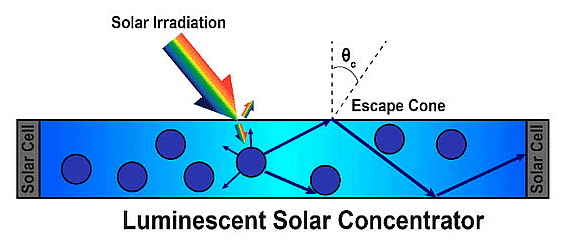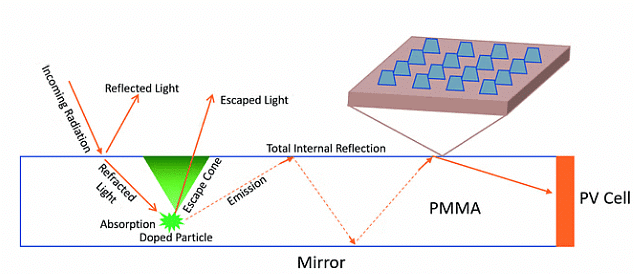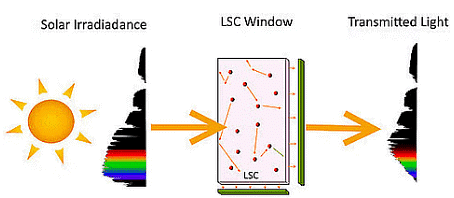Shankar IAS Summary: Renewable Energy- 2 - UPSC PDF Download
Introduction

A luminescent solar concentrator (LSC) is like a special sheet that can capture sunlight across a big surface. Instead of directly turning sunlight into electricity, it uses a thin sheet made of a special material, usually a type of plastic called polymethylmethacrylate (PMMA). This sheet is mixed with tiny particles that can glow when exposed to sunlight, like special dyes or tiny particles called quantum dots.
 Conventional cross-section of LSC
Conventional cross-section of LSC
This glowing sheet doesn't generate electricity itself. Instead, it guides the captured sunlight to the edges of the sheet, where solar cells are waiting to turn that light into electricity. So, it's like a way of concentrating and channeling sunlight to where it can be turned into power more efficiently.
What is the need for LSCs?
 Building-integrated photovoltaics (BIPV)
Building-integrated photovoltaics (BIPV)
- Luminescent Solar Concentrators (LSCs) are designed to replace expensive parts of standard solar panels with a more affordable alternative.
- The main goal is to reduce the cost of the solar panel module per unit of power produced, making solar energy more economical.
- LSCs can collect both direct sunlight and scattered light, making them effective even on cloudy days. This is an advantage over some other solar systems that rely mainly on direct sunlight.
- Unlike certain solar setups that need to track the sun's movement, LSCs don't require sun tracking systems.
- LSCs are well-suited for building-integrated photovoltaics (BIPV), meaning they can be integrated into structures like windows or walls.
- They are particularly useful in regions with cloudier climates, where they can still generate power effectively.
Ideal LSC
 Sunlight after passing through LSC
Sunlight after passing through LSC
- Catches a lot of sunlight: The material should be good at absorbing sunlight from all the different colors it comes in. Think of it like a sponge soaking up water, but in this case, it's sunlight.
- Shines all the captured light: Once it has soaked up sunlight, it should release it all as light. It's like squeezing that sponge to get all the water out.
- Big difference between taking in and giving out light: When it takes in sunlight, it should be different from when it gives out light. This helps in not losing too much sunlight during the process. Imagine if your sponge absorbed blue water and squeezed out yellow water – you'd know it did its job.
- Lasts a long time without problems: The material should keep doing this job well for a really long time without breaking or becoming less efficient. It's like having a reliable tool that works well for years.
FAQs on Shankar IAS Summary: Renewable Energy- 2 - UPSC
| 1. What is a Luminescent Solar Concentrator (LSC)? |  |
| 2. How does a Luminescent Solar Concentrator work? |  |
| 3. What are the advantages of using Luminescent Solar Concentrators? |  |
| 4. Are Luminescent Solar Concentrators suitable for all types of solar energy conversion systems? |  |
| 5. Can Luminescent Solar Concentrators be used in both indoor and outdoor settings? |  |













